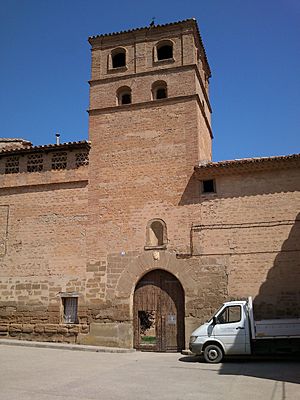Casbas Monastery facts for kids
The Casbas Monastery, also known as the Monastery of Santa Maria de la Gloria, is a very old and important building in Casbas de Huesca, a town in the province of Huesca, Aragon, Spain. It's considered a Bien de Interés Cultural, which means it's a special national monument.
This monastery was started in 1173 by Countess Oria de Pallars and her husband, Arnau Mir. They had help from Bishop Esteve de Sant Martí, who was the Bishop of Huesca. The first leader of the monastery, called an abbess, was Isabel. She guided about 30 noblewomen who joined the community.
The monastery was first home to a group of Benedictine nuns. Later, in 1196, it officially became part of the Cistercian order, which is another type of monastic group. This change was approved by Pope Celestine III.
Contents
History of Casbas Monastery
The Casbas Monastery has a long and interesting history. It was founded in the 12th century, a time when many monasteries were being built across Europe. Countess Oria de Pallars and her husband, Arnau Mir, wanted to create a place for women to live a religious life.
Bishop Esteve de Sant Martí, who helped found the monastery, had experience with Cistercian monasteries. He used to be the abbot (leader) of the Poblet Monastery. This connection might have influenced Casbas becoming Cistercian later on.
For many centuries, the monastery was a busy and important center. The abbesses, like Isabel, were powerful leaders. They managed the community and its lands. The monastery was only closed twice before 2004. These closures happened during a revolution in 1868 and during the Spanish Civil War in 1936. In 2004, the monastery became privately owned.
Architecture and Design
The church inside the Casbas Monastery is called Santa Maria de la Gloria. It was officially opened in 1208. The church was built in a style called late Romanesque. This style is known for its strong, simple shapes and rounded arches.
The church has a long main hall, called a nave, with a rounded ceiling known as a barrel vault. It is shaped like a Latin cross, which means it has a main aisle and two shorter arms. At the end of the church, there's a special area called an apse, with two small chapels on the sides.
Above the center of the church, where the main aisle crosses the arms, there's an eight-sided dome called an octagonal cupula. This dome was probably added later, around the early 1600s.
Special Features of the Church
One of the most interesting parts of the church is its main entrance, called the Romanesque portal. It was built around 1200. Above the doorway, there is a special symbol called a Chrismon. This ancient Christian symbol combines the first two letters of "Christ" in Greek. The portal also has 11 decorative arches, called archivolts, around it.
The monastery also has a cloister, which is an open courtyard surrounded by covered walkways. The arches in this cloister are from the 14th or 15th century and have a special S-shape, called ogee arches. Inside the chapterhouse, a room where the monks or nuns would meet, you can see two old stone slabs from the 14th century that were once part of tombs.
Important Art from the Monastery
Even though the monastery is now privately owned, some of its treasures can still be seen. For example, a beautiful old painting called the altarpiece of Saint Ursula, from around 1300, is now kept in the Museu Nacional d'Art de Catalunya in Barcelona. This altarpiece is a great example of the art that was once part of the monastery.
See also
 In Spanish: Monasterio de Casbas para niños
In Spanish: Monasterio de Casbas para niños


